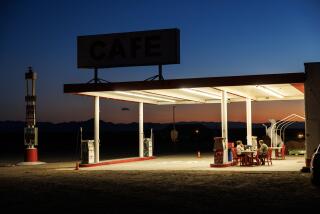Getting Their Kicks : Die-Hard Fans Put a Few More Miles on Azusa’s Love Affair With Route 66
- Share via
AZUSA — Tony Naranjo remembers when the McDonald’s restaurant on Route 66 was the place to be.
As a high school student in the 1970s, Naranjo served hamburgers and French fries to motorists and local teen-agers. “It was the happening thing to go in and have a burger” by the highway, the Azusa city councilman said.
Dorothy Steinhelper took the same road west when her family moved from Ohio in 1946. With a mobile home in tow, she and her 10-year-old daughter followed Route 66 to the orange groves of El Monte and later settled in Azusa.
Robert Whitsell, a retired San Dimas chiropractor, has driven the road 40 times on his way to and from Indiana. “I can tell you every inch of Route 66,” Whitsell said. “I pride myself on knowing it.”
They and more than 200 other fans of “America’s Main Street” turned out last week at Azusa City Hall to honor the highway and swap stories about their travels on the historic route.
“We’re down to the end of the mother road,” author and Route 66 historian Michael Wallis told the crowd, “but I know this is where the heart beats the strongest.”
Like other towns along the highway’s 2,200 miles, the history of Azusa and Route 66--now known in Los Angeles as Foothill Boulevard, Colorado Boulevard, the Pasadena (110) Freeway and Santa Monica Boulevard--are closely linked.
Opened in 1926, Route 66 was the first fully paved highway from the Midwest to the West Coast. Beginning near Lake Michigan in Illinois, the road winds through seven states and three time zones before reaching California.
In the Dust Bowl years of the 1930s, the road took displaced farmers west in search of an Eden-like California promoted by land developers. Many of these “Okies” settled in Azusa and other San Gabriel Valley towns where the citrus industry was booming. Their pilgrimage was immortalized in John Steinbeck’s “The Grapes of Wrath.”
The military later used the route to transport men and equipment west during World War II. Soldiers returning from the war vacationed up and down the highway in the 1950s. Later, it gave its name to a television series.
But more than just a source of transportation and business, Route 66 provided entertainment for locals, said Jack Williams, president of the Azusa Historical Society. “Families used to sit and watch the traffic go by,” Williams said. “There wasn’t anything to do except watch people.”
“It’s always been the main street in our community,” Azusa native Jenny Avila said.
Beginning in the 1960s, though, with the growth of the interstate highway system, the number of motorists traveling Route 66 steadily declined.
When the last of Interstate 40 was finished in 1984 near Williams, Ariz., Route 66 was bypassed by a network of five interstate highways and was expunged from most maps.
As a result, fewer motorists travel the highway and much of the charm associated with it has been lost. “Things have changed,” Naranjo said. “The communities have begun to break up. They’ve lost a warmth.”
Whitsell agrees. It is his memories of Route 66, not the current highway, that he loves.
“You can stop anywhere along here and buy enough dope to kill you,” he said. “It’s changed to dope, nitwits, puke, filth, crime and crazies.”
Although Wallis acknowledges that Route 66 has seen some rough times, he believes it will be reborn in the 1990s. Route 66 associations have sprung up in the eight states the highway crosses, and a bill by Sen. Pete V. Domenici (R-N.M.) proposes to make the road a national monument, he said.
In addition, Australian and European tourists have begun to take an interest in the highway and Japanese filmmakers have been seen scouting the road, Wallis said.
“The strong survive” and with the help of people who have loved it, Route 66 will continue as an American icon, Wallis said. “Today’s the heyday of Route 66.”
More to Read
Sign up for Essential California
The most important California stories and recommendations in your inbox every morning.
You may occasionally receive promotional content from the Los Angeles Times.













